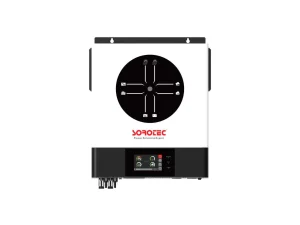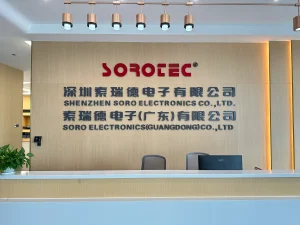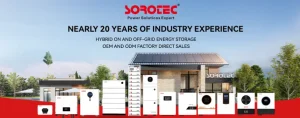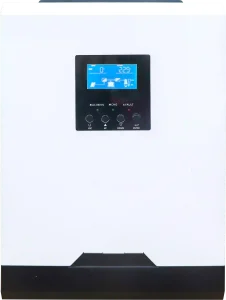Introduction
As solar technology becomes increasingly accessible and reliable, choosing the right inverter is a more critical factor than ever. Among various options, series inverters (also called string inverters) have become a preferred choice for many residential and commercial photovoltaic (PV) systems. But why should you exactly choose a series inverter for your solar energy project?
In this blog, we’ll explore the key advantages of series inverters, compare them with alternative technologies, and explain how leading manufacturers like SOROTEC Electronics deliver innovative solutions for modern solar needs.
Types of Solar Inverters
Central/String Inverters
Series or string inverters connect multiple solar panels in a “string” formation, converting direct current (DC) generated by the panels into alternating current (AC) for use or grid connection. They are ideal for systems with consistent sunlight exposure and uniform panel orientation.
Common applications:
- Rooftop residential systems
- Industrial installations with consistent panel layouts
Microinverters
Installed on each panel, microinverters optimize the output of individual units, making them ideal for shaded or complex roof geometries. However, they come at a higher cost and increased complexity.
Power Optimizers
These combine elements of microinverters and string inverters, conditioning each panel’s output before feeding it to a centralized inverter.
Hybrid Inverters
Hybrids integrate battery storage functionality with standard inverter operations. Products like SOROTEC’s REVO HMT and REVO HES series offer both on-grid and off-grid capabilities and battery communication protocols.

Key Advantages of Series Inverters
Cost Efficiency
Series inverters are more affordable than microinverters or hybrid alternatives, especially for medium to large systems. The cost savings extend beyond equipment, covering installation and maintenance as well.
At SOROTEC Electronics, the REVO VM and REVO VP series are designed to deliver high performance at competitive price points. Their modular architecture and built-in communication interfaces provide tremendous value for installers and EPCs.
Simple Installation and Maintenance
Thanks to their centralized structure, series inverters reduce wiring complexity and are easier to install. Maintenance is also simplified since only one or a few units need to be serviced.
For instance, SOROTEC’s REVO VM IV model supports online software upgrades, WiFi remote monitoring, and touch button interfaces, streamlining both initial deployment and long-term management.
High System Reliability
By placing multiple panels on a single inverter, system design and monitoring become more manageable. SOROTEC’s inverters, such as REVO HES, also support current transformer (CT) protection to prevent reverse current flow—enhancing system protection and longevity.
SOROTEC’s commitment to reliability is further backed by rigorous international certifications, long warranty periods, and real-time fault alerts, ensuring optimal system performance.
When to Choose a Series Inverter
A series inverter is ideal for:
- Residential rooftops with uniform orientation and minimal shading
- Commercial buildings with large panel arrays
- Cost-conscious solar developers prioritizing ROI
- Industrial applications where robust energy conversion is required
If your solar installation features consistent sunlight conditions and a straightforward layout, series inverters provide an unmatched balance of performance and affordability.
Series vs. Micro vs. Optimizer Inverters
| Feature | Series Inverter | Microinverter | Power Optimizer |
| Cost | ★★★★☆ | ★★☆☆☆ | ★★★☆☆ |
| Performance in shade | ★★☆☆☆ | ★★★★★ | ★★★★☆ |
| Monitoring granularity | Panel group level | Per panel | Per panel |
| Ease of installation | ★★★★☆ | ★★☆☆☆ | ★★☆☆☆ |
| Maintenance | Centralized | Dispersed | Dispersed |
While microinverters offer shading resilience, series inverters win in terms of system simplicity and affordability. Many of SOROTEC’s models offer smart load management with dual-output support, bridging the gap between string and optimizer systems.
Sizing and Compatibility Considerations
Inverter Loading Ratio (ILR)
The optimal ILR for a string inverter is typically between 1.1 and 1.3, meaning you can install more DC panel capacity than the AC output of the inverter. SOROTEC’s REVO VM IV PRO-T supports up to 27A PV input current and 450VDC input voltage, ideal for today’s high-output panels.
Future Scalability
Series inverters allow for parallel configurations. SOROTEC’s models such as REVO HMT and REVO HES support up to 6 units in parallel, enabling system expansion and even three-phase outputs—ideal for commercial or light industrial applications.
Battery and Grid Compatibility
With built-in RS485 and CAN ports, SOROTEC inverters are compatible with various BMS protocols and can function in hybrid energy setups. Their products also support grid interaction and generator input, giving users flexible energy management options.
Efficiency, Warranty and Maintenance
Conversion Efficiency
Modern series inverters achieve 95–98% conversion efficiency. SOROTEC’s high-frequency designs and MPPT (Maximum Power Point Tracking) algorithms ensure you get the most from every ray of sunlight.
Warranty
Most SOROTEC inverters come with standard 5-year warranties, extendable upon request. Products such as the REVO HES are designed with IP65 protection, ensuring long-term durability even in challenging outdoor environments.
Maintenance Cost
Centralized architecture means fewer components and reduced labor for inspections and replacements. With online upgrades and remote diagnostics, downtime is minimized.
Conclusion
A series inverter remains one of the best options for solar system owners looking for cost-effective, scalable, and reliable solutions. They strike the right balance between performance and simplicity, particularly for larger, open-area PV systems.
With advanced features such as smart load management, WiFi monitoring, and parallel scalability, SOROTEC Electronics’ series inverter lineup—including the REVO VM, REVO HMT, and REVO HES series—offers a future-proof choice for both residential and commercial solar installations.
As the world continues to embrace clean energy, choosing a high-performance series inverter from a trusted brand like SOROTEC ensures you stay ahead—technically, economically, and sustainably.
FAQs
Q1: Can I use a SOROTEC series inverter in a hybrid system with batteries?
A: Yes. Most SOROTEC inverters (like REVO VM IV, HMT, and HES series) support communication with lithium battery BMS and feature hybrid functionality.
Q2: What makes SOROTEC inverters suitable for commercial applications?
A: Their ability to connect in parallel (up to 6 units), support three-phase output, and integrate with smart energy management systems make them ideal for commercial setups.
Q3: Do SOROTEC inverters support remote monitoring?
A: Absolutely. Several models come with built-in WiFi modules or optional external connectivity kits, enabling remote diagnostics and performance tracking via mobile app or web interface.









